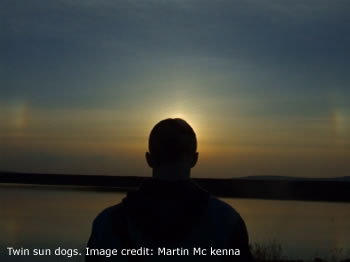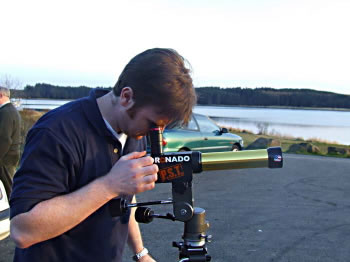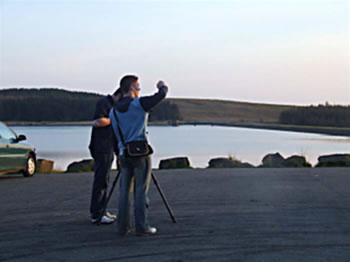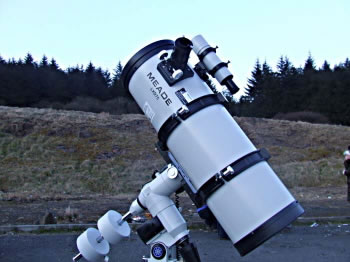
 |
Lyrid Meteor Watch From Killylane - 2006
The Reign Of Thatcher
The peak of the annual Lyrid meteor shower took place on Friday April 21/22 and the EAAS organized a watch which took place at the societies favorite observing location within the car park over looking Killylane lake outside Larne (see Messier Marathon Article). The night was open to all members and non members alike for what we hoped would be an enjoyable night watching the tail debris of comet Thatcher burning up high in the Earths atmosphere
Pre Sunset Atmospherics
Good fortune was on our side as Friday turned out to be a pleasant warm sunny day with the promise of a good clear sky as night fell. Members who arrived at 8 pm before sunset were greeted to a glorious atmospheric display around the sun. Twin multi coloured 22* sundogs begged for attention in the western sky with their glorious reflections visible on the lake.
|
|
||||||
As the sun lazily sank lower into a somewhat murky sky we could see the suns disk redden and deform into a double sun with a faint sun pillar towering over 40 moon diameters tall again with its reflection on the waters surface, only this time complimented with strips of cirrus cloud, contrails and the silent figures of several anglers doing their own kind of hunting before twilight arrived.
 |
Before sunset we had a solar observing session using Neill Patterson’s Coronado PST were some of us got our first look at the blood red solar disk in Hydrogen Alpha.
|
|
As the purple eerie glow of evening twilight faded more members arrived and two BBQ’s were set up. While the food was cooking we got superb views of planet Saturn complete with Titan, equatorial belt / zone and Cassini division through the experienced eye of a Televue refractor which gave spectacular views of the ringed world during brief moments of steady seeing.
|
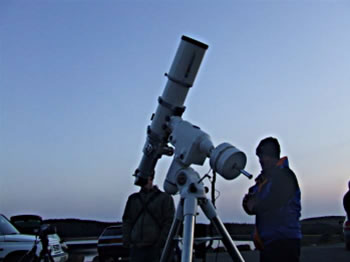 |
With 18 members in high spirits after the BBQ everyone took to their stations as the stars gradually appeared. Some of us where on chairs / sun loungers while others where gathered around a vast array of telescopes - refractors, reflectors, M.Cassegrains, SCT Casegrains and SCT- Newtonian's. Numerous satellites suddenly emerged from the Earths shadow then came the excited call ‘meteor’. It was the first of the night..the Lyrid meteor shower had begun!
The 'Harps' Strings Are Plucked
The activity was low at the beginning with just a trickle of faint Lyrids, Virginids and sporadic's however this was to be expected as the radiant located 10* SE of Vega was still low in the northern sky and we could just spot Vega winking on and off through the tree branches and besides the sky was rather murky. We entertained ourselves by watching several Iridium flares and by observing mighty Jupiter low in the SE near Alpha Librae through a selection of telescopes and binoculars, the 'king' of the planets was very eye catching shinning at magnitude - 2.0 with the planets glitter path cast across the lake towards us like a beacon.
A Dying Visitor
The late astronomer Gene Shoemaker once called planet Jupiter the ‘vacuum cleaner of the solar system’ due to the effect its massive gravity has on incoming comets which has transformed many a long period comet into one of the short period variety becoming a member of the Jupiter family of comets. As coincidence would have it we had a fine example of one such short period comet visible high in the eastern sky within the the northern crown (Corona Borealis). Periodic comet 73P Schwassmann - Wachmann 3 fragment C was now bright. We observed this icy wanderer through an 8”Sct Newtonian and 12” Dobsonian reflector fitted with wide field 2“ eyepieces. The comet was located in the same field of the famous reverse Nova (variable star) RCrB with its long 20’ dust tail pointing toward this star. 10X50 binoculars were passed around the group and we all seen the comet easily and estimated its magnitude at M1 = 7.5.
Lyrid Fireworks
After midnight the meteor rates were slowly climbing, many observers had retired for the night leaving only five members to watch the remainder of the celestial show which was now building in strength. The murk had vanished and now the sky was of a very respectable quality sporting good transparency with a bright milkyway intersected by dark rifts running parallel to the tree tops. The radiant was now much higher and the rate of activity started to gather pace as the Earth turned head on into the meteoroid stream encountering more primitive solar system debris on its eastern track around the sun. Brighter members of the shower began to appear with increasing frequency as we encountered a more dense part of the stream. The magnitudes rose from 2.0 to 1.0 the 0.0 and one earth grazer at mag - 2.0 topped by two borderline fireballs. Three cameras were set up to patrol the sky taking a time exposure near the zenith within the vicinity of Ursa Major, Ursa Minor and Draco where most of the Lyrids seemed to burn up.
|
The darkness was punctuated by glowing LCD screens, red lights and flickering flames as a second BBQ was lit for a pre dawn feast. Within this unsociable hour of the night the picturesque scene of Killylane was far from quiet with sudden outbursts of excitement and vernacular as a meteor zipped through the night sky at over 40Km/sec. The group was in high spirits and there was plenty of jokes and mischief doing the rounds. I was doing my own photographic meteor patrol centred on Bootes which Neill Patterson lovingly christened Beyonce (after the singer) which got a barrel of laughs and which I now use as my own pet name for Bootes although I doubt the celestial ‘herdsman’ would be to pleased by his new feminine name tag. Overall as a group we observed a total of 59 meteors and ended the session at 03.00 as clouds rolled in to herald an end to this years Lyrid meteor shower. |
Yet Another Successful Night
The night was an absolute success and everyone thoroughly enjoyed the show and the company of fellow observers and we did get quite an impressive meteor count which would have been higher had the sky stayed clear. As comet Thatcher’s dust trail moved off so did the red tail lights belonging to the remaining cars which now left for home leaving Killylane once again dark and silent until the next time.
Martin Mc Kenna
HOME
Also see...

